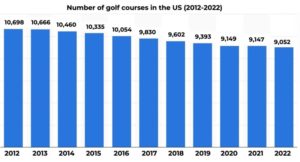By Nikhil Gharekhan, Managing Partner
The quiet, polite world of golf’s PGA Tour has been shocked by the arrival of the brash upstart, LIV Golf.
The Saudis are out to disrupt the world of golf, with their deep pockets and an innovative
The newcomer does come with significant brand risk. The biggest challenge is audience political backlash given that it is backed by Saudi Arabia’s sovereign-wealth fund and is a sportswashing exercise for Mohammed bin Salman, the Saudi leader. On the other side, LIV supporters argue that the PGA Tour is no angel either—it sponsors a tour in China and has been doing business with Saudi Arabia for decades.

LIV Golf is spending so much and creating so much change that we predict the brand will hang around and become part of golf’s landscape. It will buy its way onto viewers’ TV screens. Enough fans will get hooked on its new play formats to make it a viable venture. The question isn’t whether LIV Golf will stay or fizzle out, the question is what can the PGA Tour do now that LIV Golf has already disrupted it?
The PGA Tour has a lot of brand assets going for it. 17 of the top 18 players in the world still compete in the PGA Tour, even though stars such as Phil Mickelson and Dustin Johnson have left to join LIV. It has locked in expanded media rights for its tournaments to be shown on CBS, NBC, Golf Channel, and ESPN+, in a nine-year deal worth $7 billion. And it hosts premier golf events including The Players Championship, the FedEx Cup, and the Presidents Cup.
But the PGA Tour has not been innovating, and the kick in the gut for traditional tournament golf was bound to happen. Other than technological advances in equipment and viewing, the game has been essentially unchanged since its first documented instance in Scotland in 1457.

The PGA Tour can’t remain complacent. It is time to unleash the power of its brand to create sustainable competitive advantage. Here are some basics of brand strategy it should follow:
Brand purpose & positioning:
Today, the PGA Tour has no brand positioning at all. Its stated mission is about showcasing golf’s greatest players and positively impacting communities. But this is generic, and, besides, great players can be stolen.
The PGA Tour needs to take stock of its brand strengths, understand what its current and future audiences are looking for, and crystallize its brand purpose. It needs a compelling brand positioning that acts as a North Star for all its activities and gives people a reason to want to engage with it.
American football’s NFL brand is a good example of a powerful brand purpose for a sports association. Its brand purpose is unity—bringing together people with different backgrounds, with different beliefs uniting them by sport, across the polarized divides of our society. The idea of hope is a thread that ties together all its activities. Game formats and rules are forever tweaked to ensure that “on any given Sunday,” any team can beat any other team. At the annual NFL Combine, a week-long event, potential new players are given a chance to showcase their abilities rather than rely just on their prior achievements to gain the attention of the teams.
Brand innovation:
The PGA Tour has started to respond to the competitive pressures of the new LIV Golf. It recently announced a new tournament schedule, greater prize money, and revised criteria for selecting players. But this feels tactical, not strategic, and will only produce incremental results. The PGA Tour needs to think about more dramatic innovations in structure and format that will draw Gen Z and soon, Gen Alpha audiences.
Can a game that originated in the British Isles more than 500 years ago, and in which each tournament lasts several days, be reinvented to suit modern audiences? Yes, look at cricket. The Indian Premier League took all that is exciting about the sport, squeezed each match from 5 days into 3 hours, sprinkled in some pizzazz, and now generates more than $1B in annual broadcast revenues, the same order of magnitude as the NFL, England’s Premier League, and the NBA.
Brand architecture:
The PGA Tour brand is invisible. The popular events that it holds are not associated with this brand. People know The Players Championship, not the PGA Tour’s Player Championship. The four “major” tournaments are not linked to the PGA Tour at all, even though they are technically part of it. The brands of individual players and events have much greater prominence. Brand equity in golf is fragmented. It is not surprising, then, that the brand door is wide open for a newcomer like LIV Golf.
The PGA Tour needs to bolster its relationship to its underlying assets, visually, aurally, verbally, and textually. This will allow it to gain prominence and visibility, and with a new brand purpose and positioning, give it the permission to innovate.
Again, the NFL shows us how it can be done. Its brand is ubiquitous. For many households in the US, the second day of the weekend is not Sunday, but NFL Sunday. Even Monday and Thursday nights now bear variants of the NFL brand. Every NFL broadcast features the NFL logo, and signature music themes.
The PGA Tour has been stuck in the sand trap for too long. It has work to do if it is to survive. Brand strategy can show the way.

